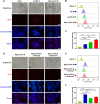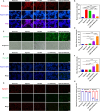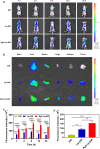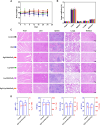Enhanced Antitumor Efficacy and Reduced Toxicity in Colorectal Cancer Using a Novel Multifunctional Rg3- Targeting Nanosystem Encapsulated with Oxaliplatin and Calcium Peroxide
- PMID: 39877588
- PMCID: PMC11774109
- DOI: 10.2147/IJN.S502076
Enhanced Antitumor Efficacy and Reduced Toxicity in Colorectal Cancer Using a Novel Multifunctional Rg3- Targeting Nanosystem Encapsulated with Oxaliplatin and Calcium Peroxide
Abstract
Purpose: Colorectal cancer (CRC) is the second leading cause of cancer-related deaths worldwide. Oxaliplatin (OXA) is currently the primary chemotherapeutic agent for CRC, but its efficacy is limited by the tumor microenvironment (TME). Here, we present a combined approach of chemotherapy and TME modulation for CRC treatment. A multifunctional nanosystem (Rg3-Lip-OXA/CaO2) was established using Ginsenoside Rg3 liposomes targeting glucose transporter 1 overexpressed on the surface of CRC cells to co-deliver OXA and calcium peroxide (CaO2).
Methods: The CaO2 nanoparticles were synthesized via the CaCl2-H2O2 reaction under alkaline conditions and characterized using X-ray diffraction (XRD) and X-ray photoelectron spectroscopy (XPS). Rg3-Lip-OXA/CaO2 was prepared through a thin-film hydration approach and characterized; additionally, its stability and release behavior were studied. The O2, H2O2, and Ca2+ generation ability of Rg3-Lip-OXA/CaO2 in solution and HCT116 cells were measured. The in vitro cellular uptake was observed via fluorescence microscope and flow cytometry. In vitro cytotoxicity was evaluated using the CCK-8 assay, flow cytometry, and live/dead cell staining. The in vivo targeting effect as well as antitumor efficacy were determined in HCT116 tumor-bearing mice. Finally, the acute toxicity of Rg3-Lip-OXA/CaO2 was investigated in ICR mice to explore its safety.
Results: The XRD and XPS analyses confirmed the successful synthesis of CaO2 nanoparticles. The Rg3-Lip-OXA/CaO2 exhibited an average particle size of approximately 92.98 nm with good stability and sustained release behavior. In vitro and in vivo studies confirmed optimal targeting by Rg3-Lip and demonstrated that the nanosystem effectively produced O2, H2O2 and Ca2+, resulting in significant cytotoxicity. Additionally, in vivo studies revealed substantial tumor growth suppression and reduced tumor-associated fibroblasts (TAFs) and collagen. Acute toxicity studies indicated that Rg3-Lip-OXA/CaO2 markedly reduced the toxicity of chemotherapeutic drugs.
Conclusion: This multifunctional nanosystem enhances chemotherapy efficacy and reduces toxicity, offering a promising approach for optimizing CRC treatment and potential clinical application.
Keywords: anticancer therapy; calcium peroxide; multifunctional nanosystem; oxaliplatin; targeted drug delivery; tumor microenvironment.
© 2025 Xie et al.
Conflict of interest statement
The authors report no conflicts of interest in this work.
Figures










Similar articles
-
Efficacy-shaping nanomedicine by loading Calcium Peroxide into Tumor Microenvironment-responsive Nanoparticles for the Antitumor Therapy of Prostate Cancer.Theranostics. 2020 Aug 2;10(21):9808-9829. doi: 10.7150/thno.43631. eCollection 2020. Theranostics. 2020. PMID: 32863961 Free PMC article.
-
Ginsenoside Rg3 targets cancer stem cells and tumor angiogenesis to inhibit colorectal cancer progression in vivo.Int J Oncol. 2018 Jan;52(1):127-138. doi: 10.3892/ijo.2017.4183. Epub 2017 Nov 1. Int J Oncol. 2018. PMID: 29115601 Free PMC article.
-
Ginsenoside Rg3 enhances the anticancer effects of 5-fluorouracil in colorectal cancer and reduces drug resistance and the Hedgehog pathway activation.Arab J Gastroenterol. 2024 Nov;25(4):437-443. doi: 10.1016/j.ajg.2024.09.003. Epub 2024 Nov 4. Arab J Gastroenterol. 2024. PMID: 39500672
-
Nanoparticles Containing Oxaliplatin and the Treatment of Colorectal Cancer.Curr Pharm Des. 2023;29(38):3018-3039. doi: 10.2174/0113816128274742231103063738. Curr Pharm Des. 2023. PMID: 37990895 Review.
-
Glycyrrhizic acid-based multifunctional nanoplatform for tumor microenvironment regulation.Chin J Nat Med. 2024 Dec;22(12):1089-1099. doi: 10.1016/S1875-5364(24)60685-0. Chin J Nat Med. 2024. PMID: 39725510 Review.
References
MeSH terms
Substances
LinkOut - more resources
Full Text Sources
Medical
Miscellaneous

